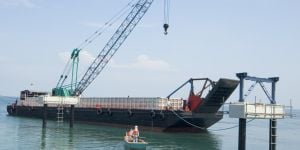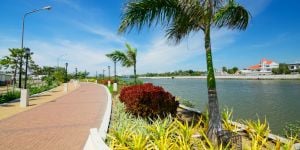A lot of my friends asked it is wise to invest money in Philippine? I giving an example that even a big gun like Singaporean-backed conglomerate LKY Property Holdings could not meet the deadline and face problems for its rehabilitation work on the landmark MacArthur Park Beach Resort Hotel which has been set for October this year. Very Unusual as a Singaporean meeting deadline is one of our trademark efficiency .
with existing process, rules and regulation in place meeting deadline in project is like second nature to us.
Not so in Philippine, your deadline might not be their, they have their own set of rules and regulation, rules might also not be rules but only serve as a guide, not as though that it was cast in stone sometimes you got play it by the ears. There are also many hidden and unseen factor like network connection and having virtue of patience is the most important factor. The thumb of the rule is not who you are back home but who you know over here, moreover your urgency might not be in your top favorite list.
From my observation, a few countries that had deep rooted and generation of experience working together with the Philippine are the USA, Japan, Korea, China.
So how they do it ? the first wave is always start off an an individual company, enterprising trader that had deep knowledge and connection locally. Using US as a case study , tracing back to history, they had set their footprint since WW2, the U.S.-Philippine relations are based on shared history and commitment to democratic principles, as well as on economic ties and even military ties.
Naturally they are very successful group here, many project development in every remote of Philippine. China seems to make their presence here very strongly during these recent year, not surprising they seems to be everywhere. Japan is in a very charitable manner, they would invest millions just to give, Google "japan charity in Philippine" you will get an idea. I asked one my Philippine friend why is these so ? He just give a plain answer what they did in WW2 in Philippine. Maybe, Atonement is a strong factor here, they managed to win the hearts of Filipino. If you walk around town, I always mistaken as a Japanese, Chinese from china or a korean, never a Singaporean. When you become an household words is much more easily to get thing done around here !
How about the individual entrepreneur like the UK, Germany, UAE also have their own niche of business in Philippine. They there started off with a friend who know somebody, who had been around on the ground doing business in Philippine a local countryman who had integrate into the Filipino community task to overseen the the development of the project and a point of contact they a tight niche of trust circle partnership without the hanky panky business, a sense of direction and focus of what they want and invest their capital in the project.I operated an internet cafe and Restaurant I might have a 15% return on investment (ROI) but also lot of headache from the daily management/operation. In Guibang things move slower here; sometimes even grind to a halt if there is a blackout, typhoon and the unexpected factors that you will never find in Singapore.
Some friend might want to invest in a a resort , an apartment in the Philippines?
At least all work would be done for you, but ask the developer how much the ROI will be. Apartment are not really meant to be an investment; it's a luxurious second home. Like Singapore you only own 'the space between the walls of the room' for as long as the apartment exists as you do not own the a piece of that.
How about farming? I had try crops like corn and live-stock, giving about 5 to 8% ROI using labor intensive method of farming you might try to apply the latest technology and expensive machinery it might have a higher return in ROI but that is not so feasible on a small scale project less than 60 hectares.
Nowadays, organic products is causing wave locally and aboard , henceforth, Organic Agricultural Products ROI is much higher than any other way to invest money in the Philippines. Philippines has all that is required to produce extremely high yields in agriculture; what is lacking is mostly the implementation of the latest know-how and technologies. If you want investment in the Philippines then agriculture is the most obvious answer since this country has all that is required nature resources, experienced farmer and labors to produce extremely high yields, what is lacking is mostly the implementation of the latest know-how and technologies
To start off with a reasonable, sizable scale investment like 60 hectare of agricultural land get the ball rolling and let it become a fact and success, that will attract more investor either invest more money and/or offer their expertise progressively to purchase another 60 hectare, if we have 120 hectare agricultural land building a Singapore retirement village resort is another added value in the premise. Overall organic products can give a ROI of 50% for more than 75 years; even your generation of grandchildren of had a piece of the history. Wise investment is to think 'outside the box'.
Avocado is not considered a major fruit in the country and is planted mostly in backyards, only a limited amount of planting material is being produced in a few government institutions and private nurseries. Planting materials may come in the form of grafted plants or seedlings for rootstock use. Government agencies such as the Bureau of Plant Industry of the Department of Agriculture and the University of the Philippines Los Baños, particularly the National Seed Foundation and the Department of Horticulture, produce a few hundred grafted plants of locally available varieties. Small private nurseries which also sell sexually propagated avocado plants are a good source of seedling rootstocks for propagation. Seedlings grown in the nurseries are heterogeneous - each seedling different from another, even though the seeds may have come from one variety or only from one parent tree. The commonly used and preferred method for large-scale propagation is grafting. This method is less labour-requiring, faster and economical in the use of scion materials. In the case of cleft-grafting, 6-12 months old seedlings are used as rootstocks. Budwood sticks are obtained from the season's mature growth with well-developed terminal buds. New shoots are formed within three to four weeks.
We do our best to provide accurate and up to date information. However, if you have noticed any inaccuracies in this article, please let us know in the comments section below.






